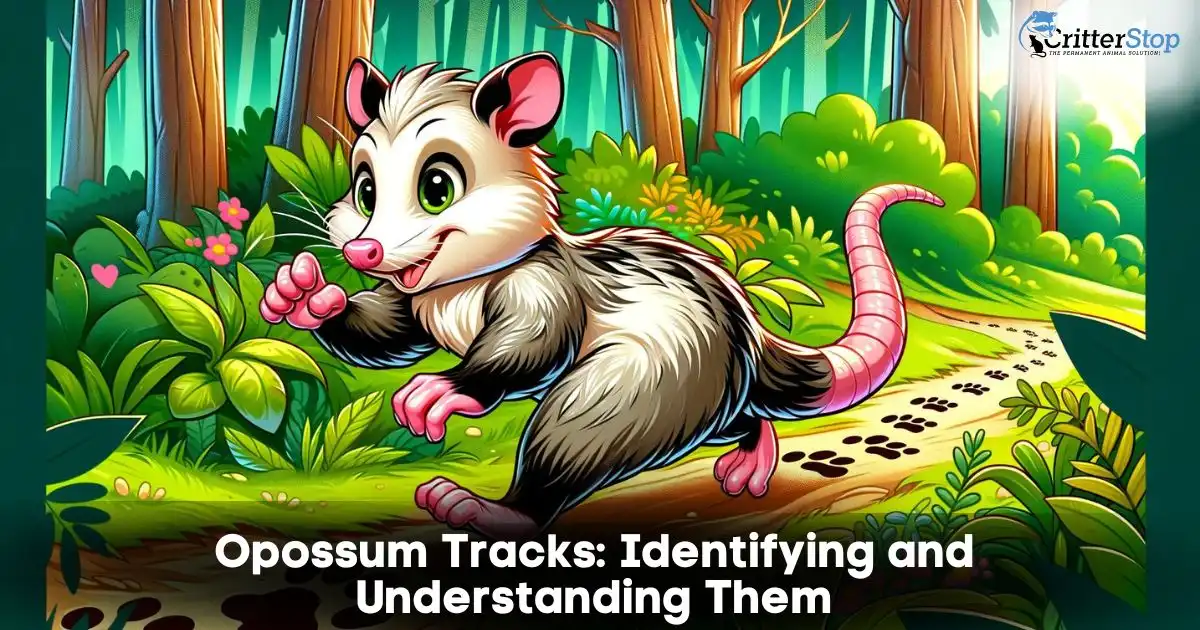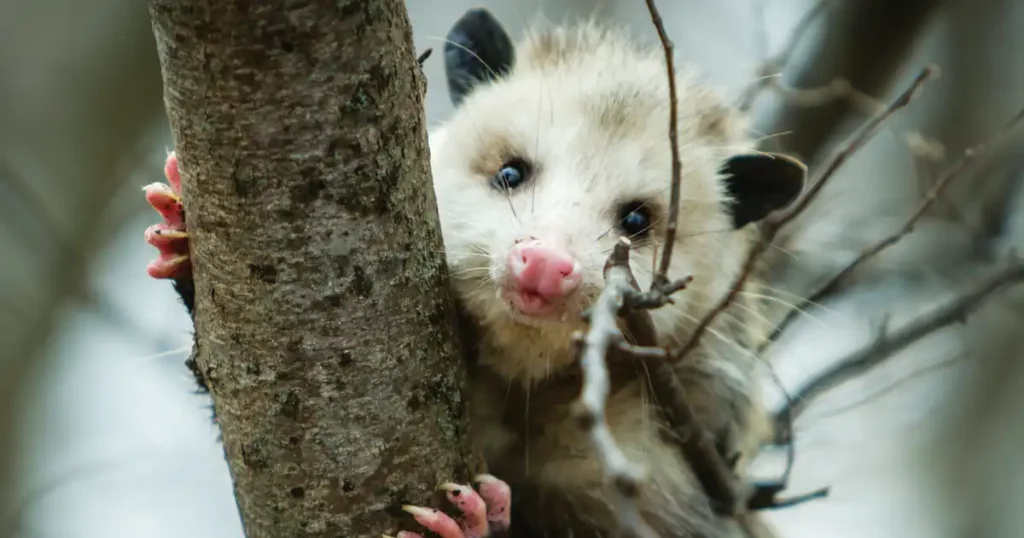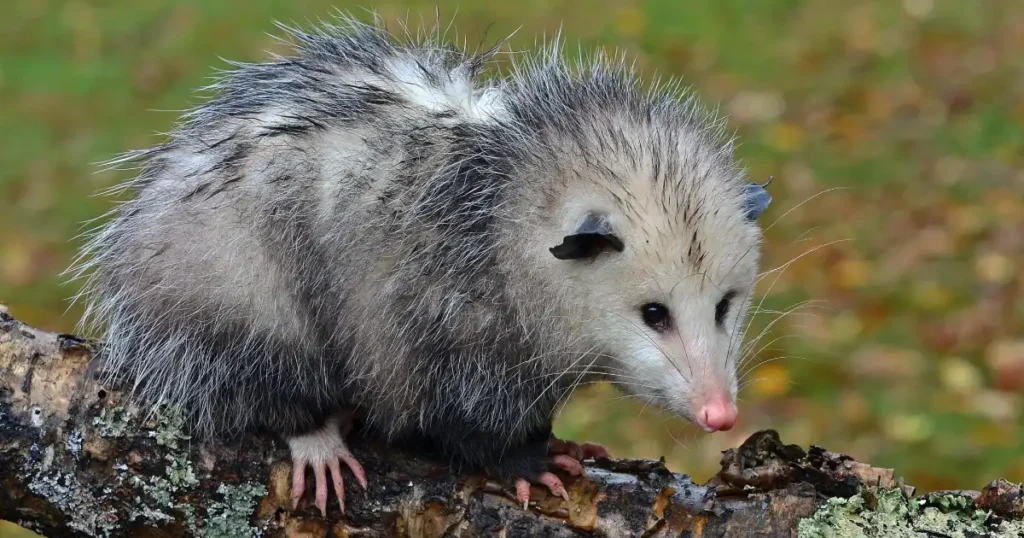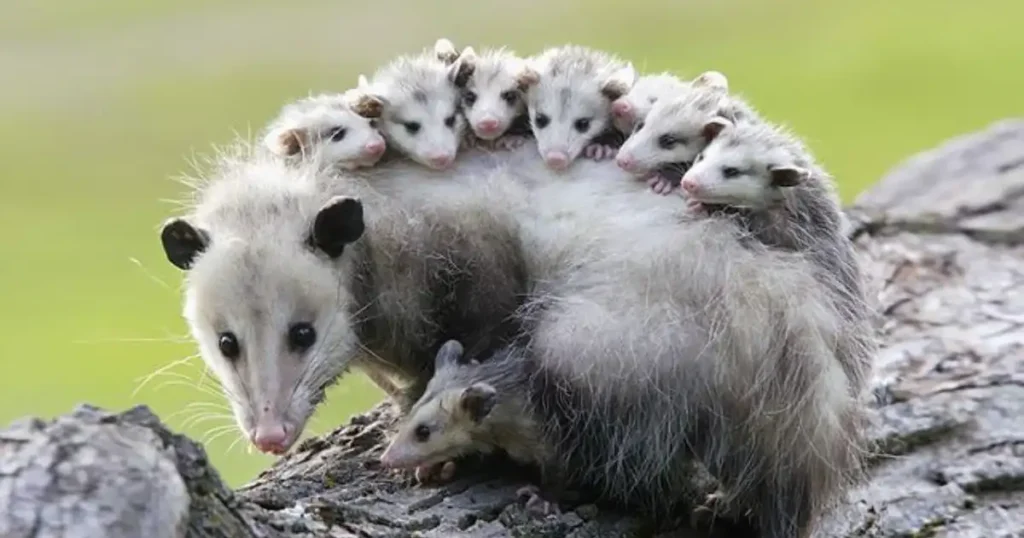
Opossums are one of the most common mammals found in North America. They're recognized for their distinctive looks, nighttime behaviors, and their inclination to feign death when feeling endangered. However, one aspect of opossums that is often overlooked is their tracks.
As the seasons shift and early spring brings new life to the land, it's not uncommon to notice mysterious tracks along trails and in fine soil. Among these tracks, the distinctive prints of opossums often catch the eye of those who walk the trails at night or early in the morning. Opossum tracks can reveal intriguing insights into the habits and movements of these nocturnal creatures, shedding light on their behavior in the wild.

Opossums leave behind tracks that bear unique characteristics, distinguishing them from other animals like red foxes or gray foxes. Their tracks typically consist of five toes on each hind print and four toes on each front print. The rear prints tend to be larger than the front prints, with the rear foot measuring up to 3 inches in length. Additionally, opossum tracks may display asymmetry, with the inner toe on the rear foot being shorter than the outer toe. These distinctive features can help differentiate opossum tracks from those of other animals, such as dog tracks or small dogs.
Opossum tracks can provide valuable information about these animals, including their size, movement patterns, and behavior. Opossums have five toes on each foot, with the front feet being slightly smaller than the back feet. Their tracks are distinctive, with the hind feet leaving a larger, more rounded print than the front feet.
Opossum foot prints can be found In diverse environments, encompassing woodlands, meadows, and residential regions, they dwell. They frequently inhabit locales close to water bodies like creeks or lakes, given the opossums' adept swimming abilities. Analyzing opossum footprints offers scientists valuable clues into the actions and environmental interactions of these captivating creatures.

Opossums are nocturnal creatures that are common in North America. Identifying their tracks can be helpful in determining their presence in an area. Here are some characteristics of opossum tracks to look out for:
When walking along trails or through wooded areas, keep an eye out for opossum tracks in fine soil or soft ground. Opossums often leave their tracks in areas where they frequent, especially near water sources or along the edges of forests. By examining the direction of the tracks, you may notice patterns indicating the movement of the opossum. Opossum tracks typically show a staggered pattern, with the rear prints slightly ahead of the front tracks, especially when walking in the opposite direction.
Opossums typically possess five toes on their rear paws and four toes on their front paws. Their footprints commonly display asymmetry, where the inner toe is shorter compared to the outer toe. The hind paws tend to be larger than the front paws, measuring up to 3 inches in length. The tracks can range from 1 to 3 inches in length, depending on the size of the opossum.
The paw prints of opossums are distinctive because of the opposable thumb on their hind feet. This thumb is set at a 90-degree angle to the other toes, making it easy to identify their tracks.
Opossum tracks can be found in a variety of substrates, including mud and sand. In mud, their tracks will be deep and may show claw marks. In sand, their tracks will be shallow and may not show claw marks.
When identifying opossum tracks, it is important to note the size of the tracks and the presence of the opposable thumb on the hind feet. This can help distinguish them from other animals, such as raccoons or cats.
In conclusion, identifying opossum tracks can be a useful tool in determining their presence in an area. By looking for the characteristics of their paw prints and considering the substrate in which they were found, one can confidently identify opossum tracks.

Opossums are unique creatures that have distinct physical features. One of the most notable features is their paw anatomy. Opossums have five toes on each of their front paws and four toes on each of their hind paws. The toes are flexible and can move independently, allowing them to grasp onto tree branches and climb with ease.
Opossum paw prints are easily recognizable due to their distinctive structure. The prints of their front paws are larger than those of their hind paws. The prints of their front paws also have a thumb-like structure that is set apart from the other four toes. This thumb-like structure is called an opposable digit. The opposable digit is used to grasp onto objects and hold onto prey.
Opossum paw prints are also unique in that they have a distinctive pattern. The pattern is made up of five toes that are arranged in a semicircle. The toes are spread out and have a distinct space between them. This pattern is easily recognizable and can be used to identify opossum tracks in the wild.
In conclusion, understanding the anatomy of opossum paws is crucial for identifying opossum tracks in the wild. The unique structure of their paw prints, including the opposable digit and distinctive pattern, makes them easily recognizable to those who are familiar with what signs to search for.

When it comes to identifying opossum tracks, it's important to know how they differ from other animals in the same habitat. One common animal that can be confused with opossums are raccoons. While both animals have five toes, there are some key differences to look out for.
Raccoon tracks are generally larger than opossum tracks, with the hind feet measuring around 3-4 inches in length. In contrast, opossum tracks are smaller, with the hind feet measuring around 2-3 inches in length. Additionally, raccoon tracks tend to have a wider spread than opossum tracks.
Another distinguishing feature is the shape of the toes. Raccoon paw prints have more rounded toes, while opossum toes are more pointed. This can prove particularly beneficial when attempting to discern tracks or opossum imprints in muddy or snowy conditions.
It's not just raccoons that can be mistaken for opossums. Other animals in the same habitat, such as cats, dog, and even rodents, can leave similar tracks. However, there are some key differences to look out for when trying to identify opossum prints.
One important feature to look out for is the opposable thumb on the hind foot. This is a unique feature to opossums and can be used to distinguish their tracks from those of other animals. Additionally, opossum tracks tend to have a more irregular pattern than other animals, with the toes often pointing in different directions.
Overall, while it can be challenging to identify opossum tracks amongst other species, paying attention to the size, shape, and pattern of the tracks can help you make an accurate identification.

Opossums are nocturnal creatures that are known for their distinctive tracks. Tracking opossums by their tracks can be a fun and educational experience for nature enthusiasts.
Opossums possess five toes on their rear paws and four toes on their front paws. Their tracks are generally around 2-3 inches long and 1.5–2.5 inches wide. Opossums tend to walk with a slow, lumbering gait, and their tracks show a distinctive pattern of a hind foot followed by a front foot.
When tracking opossums, it is important to pay attention to the direction of their movement. Opossums often move in a zigzag pattern, which can indicate that they are searching for food. They also tend to climb trees and may leave tracks on the trunks and branches.
Opossums are widespread across North America and inhabit various environments, ranging from woodlands and meadows to suburban landscapes. They frequently reside close to water bodies like streams and ponds.
Opossum tracks can be found in a variety of substrates, including mud, sand, and snow. When tracking opossums in mud, their tracks may show claw marks, which can help distinguish them from raccoon tracks. Opossum tracks in mud are often more spread out than raccoon tracks, which tend to be more compact.
In conclusion, tracking opossums by their tracks can be a fun and educational experience for nature enthusiasts. By paying attention to the direction of their movement and the habitats they are found in, it is possible to learn more about these fascinating creatures.
Opossums are omnivorous animals that feed on a variety of food sources, including insects, fruits, nuts, and small animals. Their tracks can provide insights into their feeding behavior. For example, if tracks show that an opossum has been digging in the ground, it may indicate that it was searching for insects or roots to eat. Similarly, if tracks show that an opossum has been climbing a tree, it may indicate that it was searching for fruits or nuts.
Opossums are known to mark their territories with their scent. Their tracks can provide insights into their territorial behavior. For example, if tracks show that an opossum has been repeatedly walking along the same path, it may indicate that it is marking its territory. Similarly, if tracks show that an opossum has been urinating or defecating in a certain area, it may indicate that it is marking its territory with its scent.
In conclusion, opossum tracks can provide valuable insights into their behavior. By analyzing their tracks, researchers and enthusiasts can gain a better understanding of these fascinating animals.
Opossums are known for their unique track patterns, which can be identified by their distinctive features. Understanding these patterns can help in identifying the presence of opossums in the area and their behavior.
Opossums have a distinctive gait pattern that is characterized by their hind feet overlapping their front feet. This overlapping pattern creates a distinctive track sequence that can be used to identify opossum tracks. The track sequence of opossums is as follows: right hind foot, left hind foot, right front foot, and left front foot.
In mud, opossum tracks can be identified by their five-toed footprints, with the hind feet being larger than the front feet. The hind feet also have opposable thumbs, which are used to grasp branches and climb trees.
The track patterns of young opossums differ from those of adults. Young opossums have a more symmetrical track pattern, with their hind feet overlapping their front feet in a straight line. As they grow older, their hind feet start to overlap their front feet at an angle, creating the distinctive track sequence mentioned above.
In conclusion, understanding the track patterns of opossums can help in identifying their presence and behavior. By observing the distinctive track sequence and footprints, one can easily identify opossum tracks in mud and other soft surfaces.
Weather conditions can greatly influence the appearance of opossum footprints. Heavy rain or snow can wash out or distort tracks, making them difficult to identify. On the other hand, dry and hard ground can make tracks more visible and easier to spot.
Additionally, the temperature can also affect the appearance of tracks. In cold weather, tracks may appear smaller and more compact due to the animal's fur being fluffed up for warmth. In warmer weather, tracks may appear larger and more spread out due to the animal's fur being flattened against its body.
The season can also affect the appearance of opossum tracks. During the winter months, opossums may be less active and their tracks may be less frequent. In the spring and summer, opossums may be more active and their tracks may be more abundant.
Furthermore, the type of terrain can also affect the appearance of tracks. In areas with thick vegetation, tracks may be more difficult to spot and identify. In areas with soft soil, tracks may appear deeper and more pronounced.
Overall, it is important to consider environmental factors when identifying opossum tracks. By taking into account the weather conditions, season, and terrain, one can better identify and understand the behavior of these unique animals.
Photographing opossum tracks can be a challenging task, but with the appropriate methods and tools, it can be accomplished efficiently. Here are some best practices for track photography:
Photography can be a useful tool for identifying opossum tracks. Here are some tips for using photography to identify tracks:
By following these best practices and using photography to aid in identification, you can become a more skilled tracker and better understand the habits and movements of opossums in your area.
When tracking opossums, it is important to do so in a responsible and ethical manner. This means minimizing disturbance to their habitat and avoiding any potential harm to the animals themselves. Some tips for responsible tracking include:
By following these guidelines, trackers can minimize their impact on opossum populations and help ensure the animals' continued survival.
Tracking opossums can also contribute to their conservation by providing valuable data on their behavior, habitat use, and population size. This data can aid in guiding conservation initiatives and safeguarding opossums and their environments.
In addition, tracking can help raise awareness about opossums and their importance in ecosystems. By sharing their tracking experiences and knowledge with others, trackers can help promote conservation and encourage others to appreciate these unique animals.
Overall, responsible and ethical tracking can play an important role in opossum conservation efforts while also providing a rewarding and educational experience for trackers.
Opossum tracks can be a valuable tool for teaching students about wildlife and their behavior. By learning to identify tracks, students can develop a better understanding of the animals that live in their local environment. Teachers can incorporate opossum track identification into their lesson plans by taking students on nature walks and pointing out tracks along the way. They can also use pictures or plaster casts of opossum tracks to help students learn to identify them.
In addition to learning about opossums, students can also learn about the different types of tracks that animals leave behind. They can learn to identify tracks from other animals, such as deer, raccoons, and squirrels. This can help students develop a greater appreciation for the diversity of wildlife in their area.
Opossum tracks can also be used in community science projects. Citizen science projects involve volunteers in scientific research and data collection. By collecting data on opossum tracks, volunteers can help researchers learn more about opossum behavior and distribution.
One example of a community science project involving opossum tracks is the Opossum Project. This project involves volunteers collecting data on opossum tracks in their local area and submitting the data to a central database. The data is then used by researchers to study opossum behavior and distribution.
Community science projects can be a fun and educational way for people to get involved in scientific research. By participating in these projects, volunteers can learn about wildlife and contribute to important research at the same time.
In conclusion, opossum tracks can be a valuable tool for teaching students about wildlife and for involving the community in scientific research. By learning to identify opossum tracks, students and volunteers can develop a greater appreciation for the diversity of wildlife in their area and contribute to important research.
For those interested in learning more about opossum tracks, there are several resources available online and in print.
One useful online resource is the Opossum Society of the United States website, which provides information on opossum behavior, habitat, and tracks. The website also offers a downloadable guide to opossum tracks, which includes detailed illustrations and descriptions of the different types of tracks that opossums leave behind.
Another valuable asset is the publication "Mammal Tracks and Indicators: An Illustrated Handbook to North American Species," authored by Mark Elbroch. This comprehensive guide covers the tracks and signs of all North American mammals, including opossums. The book includes detailed illustrations and descriptions of opossum tracks, as well as information on opossum behavior and habitat.
For those interested in field research, the Tracking and Nature Observation program offered by the Wilderness Awareness School provides hands-on training in tracking and observation skills. The program includes instruction on identifying and interpreting opossum tracks, as well as other types of animal tracks and signs.
In conclusion, numerous sources are accessible for individuals keen on delving deeper into opossum footprints. Whether you prefer online resources, books, or hands-on training, there are options available to suit a variety of learning styles and interests.
Opossum tracks are generally smaller than raccoon tracks, and they have a distinctive shape. Opossum tracks have five toes, with the hind feet resembling a human hand. The front feet have five toes as well, but the thumb is opposable, which makes the track look like a small handprint. Raccoon tracks, on the other hand, have five toes on both the front and hind feet, but the toes are more elongated and pointed.
Opossum tracks in mud are usually well-defined, with clear toe prints and a visible palm pad on the hind feet. The front feet may also show a palm pad, but it is less prominent. Opossum tracks in mud can be distinguished from other small mammal tracks by their unique shape and size.
In snow, opossum tracks can be difficult to distinguish from other small mammal tracks. However, opossum tracks are generally smaller than raccoon tracks and have a distinctive shape. The hind feet resemble a human hand, and the front feet have an opposable thumb, which makes the track look like a small handprint.
Opossum tracks in sand are usually well-defined, with clear toe prints and a visible palm pad on the hind feet. The front feet may also show a palm pad, but it is less prominent. Opossum tracks in sand can be distinguished from other small mammal tracks by their unique shape and size.
Yes, opossum tracks in a yard can be identified by their unique shape and size. Opossum tracks have five toes, with the hind feet resembling a human hand. The front feet have five toes as well, but the thumb is opposable, which makes the track look like a small handprint.
When looking at pictures of opossum feet, you should look for the distinctive shape of the tracks. Opossum tracks have five toes, with the hind feet resembling a human hand. The front feet have five toes as well, but the thumb is opposable, which makes the track look like a small handprint. The tracks may also show a visible palm pad on the hind feet.
Opossums, known for their adaptability and occasional intrusion into residential areas, can present challenges for homeowners. However, when faced with the nuisance of opossum invasions or the need for effective removal services, the solution lies with Critter Stop.
If an opossum is causing problems, such as rummaging through garbage or causing damage to property, there are humane ways to address the issue. At Critter Stop, we have been providing opossum removal services for years in the North Texas area, assisting homeowners in safeguarding their families, pets, and property from opossum-related damages. Contact Us at (214) 234-2616 to receive a free estimate for our services.
Visit our Critter Library and learn more about our furry friends